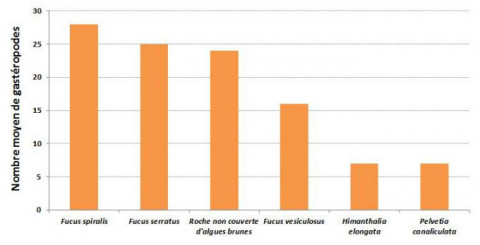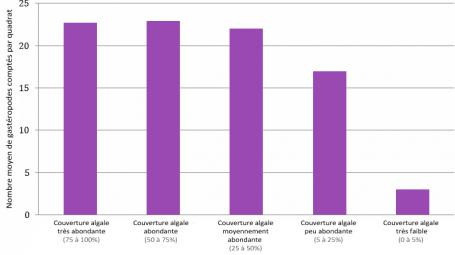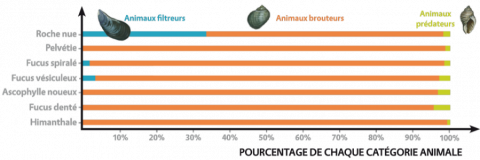Some scientific results of BioLit
The first participatory observatory of the BioLit program for the Atlantic-Channel-North Sea coast is studying the link between brown algae and the gastropods that live on them.
The study issue
For about twenty years, brown seaweeds have been declining without really knowing why. This regression has been observed in certain points on the Breton coasts, but it does not seem to affect all the species or all the foreshore. In fact, according to a satellite monitoring, the algal cover is progressing or even stabilizing on some foreshores, especially in Brittany.
Launched in 2011, the objectives of the program are to better understand:
- the location of rocky foreshores gastropod populations
- the associations between brown algae and gastropods
- the effects of human pressures on brown algae
- the effects of environmental factors on brown algae / gastropod assemblages
Abundance of the studied gastropods
The most common species on the foreshores are: the umbilical gibbula (Gibbula umbilicalis), the common gibbula (Gibbula pennanti), the obtuse littorine (Littorina obtusata).
On the other hand, among the less present species, the Japanese borer (Ocenebra inornata), an introduced species that predates oysters, the gibbule mage (Gibbula magus), whose distribution on the coasts is not well known and which normally lives low on the foreshore, and the calliostoma (Calliostoma zizyphinum), which also lives very low on the foreshore.
Our hypothesis is that there is a relationship between algal cover, position on the foreshore and the abundance and diversity of gastropods. Classically, an increase in diversity is observed from the top to the bottom of the foreshore, while abundance varies according to many other factors.
Based on the 2013 data, although the number of observations is not yet large enough to allow for a robust analysis of the results, it would appear that gastropods have a fairly strong habitat preference for spiral wrack (Fucus spiralis) and toothed wrack (Fucus serratus).
Is there a relationship between algal cover and gastropod abundance?
Brown algae play a major role in the ecology of the foreshores. Keeping humidity at low tide (they play the role of a sponge), they limit the effects of desiccation. Thus, many species take refuge between the algae.
When this algal cover is in regression, do the gastropods manage to maintain themselves?
We analyzed gastropod abundance in relation to algal cover.
When the cover is very abundant (between 75% and 100% algal cover), the observers counted an average of 22.7 individuals per quadrat. This abundance is only 17 individuals per quadrat when the cover is low (between 5% and 25% algal cover).
It is interesting to see that not all species react in the same way to these modifications of the algal cover. Some of them, more tolerant to desiccation conditions, suffer less from these modifications.
In addition, limpets would limit the establishment of Fucus by grazing on young algae. The limpets themselves can only settle in areas where there are few barnacles. The interactions between species on the foreshore are therefore complex. Many factors come into play with each other, playing a role in the dynamics of brown seaweed cover.
Through your observations in the field and their feedback to the scientific team, you are a real actor in the research on these interactions for a better understanding of the factors controlling the algal cover.
Positioning your data
The molluscs you have observed have different diets. These organisms are therefore more or less numerous in the different algal belts depending on the quantity of food available to them. Does the distribution between the 3 groups (filter feeders, grazers, predators) that you observed correspond to the average of the observations?
Using this graph :
This graph allows you to assess whether the proportion of filter-feeding / grazing / predatory gastropods that you have observed corresponds to the average of the observations. Be careful to position yourself on the algal belt(s) that you have studied.
Understand your result:
The gastropods living on the rocks appear to be well structured from the top to the bottom of the foreshore, particularly in terms of diversity. Indeed, your observations show that the number of animal species is maximal on the second algal belt of the foreshore (spiral wrack), then decreases as you go down the foreshore. In addition to this quantitative aspect, the proportion of filter-feeding / grazing / predatory gastropods can also be taken into account, as it allows us to evaluate the organisation of the communities according to the algal species chosen. An overabundance of filter feeders can be observed in conjunction with a low coverage of the rock by brown algae. This lack of algal cover can itself be caused by an overabundance of grazers (this is the case in particular of limpets which specifically limit the cover of knotted Ascophyllum), pollution or even global warming. This is the scientific issue that is at the heart of BioLit! Finally, the programme also aims to understand the organisation and functioning of this ecosystem, and in particular the competitive phenomena that can exist between grazing/filtering gastropods and predators. The number of predators is itself influenced by the number of species of grazers: predators are generally specialised on a few species (for example, the purple one is specialised on the predation of mussels and barnacles)..




